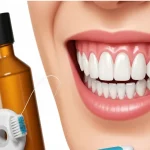A dazzling, bright smile is usually considered a symbol of healthiness, youth, and confidence. Therefore, whitening procedures have become one of the most renowned options in cosmetic dentistry to pamper beauty in a quick and painless manner. But in reality, the world of teeth whitening can become a bewildering journey with different products, promises, and oohs competing for attention. It, therefore, becomes essential to comprehend some basics about how teeth get discolored, how whitening happens, what methods exist, what limitations it might have, and what side effects could come with it; that way, one can do the right things to get effective results safely. However, the best way to start out is to meet with a dental expert to develop a professional plan for your bright smile.
What Causes Teeth Staining?
There are several reasons why teeth lose their brightness and beauty. From a gross point of view, stains are divided into extrinsic and intrinsic stains. Extrinsic discoloring agents usually would be pigmented foods and any beverage considered as a staining medium such as coffee, tea, red wine, dark berries, and colored sauces. Tobacco products are highly insoluble surface stains created by tar and nicotine. Over time, these pigments reach the very minute pores of tooth enamel to cause discoloration. Intrinsic discoloration occurs deep within the tooth structure. Teeth tend to darken with age due to the natural thinning of the outer layer of enamel which reveals more of the yellowish dentin beneath. Some medications such as certain antihistamines, antibiotics (particularly tetracycline if taken during tooth development), drugs for high blood pressure, or chemotherapy can cause some drastic internal staining. Discoloration may occur from tooth injury or trauma and even excessive fluoride.
How Does Teeth Whitening Work: Chemistry Behind the Shine?
The chemistry behind teeth whitening in fact involves an oxidation process of bleaching where the active ingredient used is primarily hydrogen peroxide or a related compound called carbamide peroxide. Once these bleaching agents are applied over the teeth, they undergo decomposition into free oxygen molecules. These oxygen molecules are then able to penetrate the microscopic pores of the tooth enamel and dentin. Once inside the pores, the oxygen molecules physically interact with the staining agents and break the larger and complex molecules of the stain into smaller and less colored molecules. The oxidation reaction, in short, lightens the shade of the tooth from darker tones of staining to lighter color, not by physically scrubbing away stains but rather by chemically transforming larger, darker pigments into smaller, lighter ones without impairing the tooth structure itself.
Teeth Whitening Options: Choose Your Custom Treatment
Teeth whitening options are widely different in terms of concentration, mode of application, and efficacy.
In-house Professional Whitening: This is the fastest and most controlled method under direct supervision of a dentist. Higher concentrations of whitening gel are used, often in combination with a special light or laser to accelerate the process. Dramatic results can be seen after one or two sessions, perfect for the client looking for immediate, intense whitening.
At-Home Whitening by a Professional: A dental professional prepares trays with a bleaching gel of professional strength. The gel concentration in this option is lower than in-office care; however, since custom trays are designed to sit evenly on the teeth, they maximize the time that bleaching gel is in contact with the teeth, thereby producing really good results in one to two weeks and offering both convenience and professional oversight in the process.
Over-the-Counter Options: These include whitening toothpastes, rinses, strips, and generic trays bought at any market. They contain the bleaching agents at a much lower concentration, with the main function of removing surface stains. While they might actually create a mild improvement, the whiteners really can’t yield the more dramatic and long-lasting results of professional-oriented products. And, whitening toothpastes usually use mild abrasives as a method to polish away surface stains rather than actually altering intrinsic staining in the color of a tooth.
Whitening Won’t Work on All Teeth: Limitations of Teeth Whitening
One needs to have a sense of realism as to what can be expected from tooth whitening procedures. Whitening treatments have varying degrees of suitability for the treatment of different colorations. Generally, although yellowish discolorations usually represent an ideal candidate for bleaching efforts, brown discolorations are the opposite. Teeth with gray or purplish discolorations, which are generally related to discoloration through certain medications or very intense intrinsic staining, usually do not become significantly whiter. Furthermore, restorations such as crowns, fillings, veneers, and caps do not change color when exposed to whitening agents. This may mean that restorations on visible teeth will cause them to stand out after whitening of the natural teeth, requiring replacement so they will match the new color. A thorough examination by the dentist will determine whether whitening is suitable for the type of discoloration affecting an individual and whether existing restorations might be a factor.
Side effects of Teeth Whitening: What to Expect?
There are possible side effects to teeth whitening, although not many-and these need to be balanced against the need to create a brighter smile. The most commonly reported side effect is increased tooth sensitivity:// This arises when the whitening agent irritates the nerve of the tooth. The feeling is usually mild and disappears after a few days of treatment. The other side effect of whitening is irritation of the gums, especially if the gel comes into continued contact with the soft tissues. If one uses these kinds of products too often or applies them inappropriately, for instance if one uses poorly fitting trays, one will increase the risk for side effects and, rarely, one may even damage gum tissue or tooth enamel when one is not careful enough. So be sure to use what you are given following your treatment closely, or better yet, ask your dentist for help so that you can enjoy a safe and effective whitening experience with the most minimal discomfort and maximum results.






